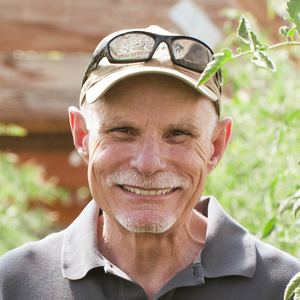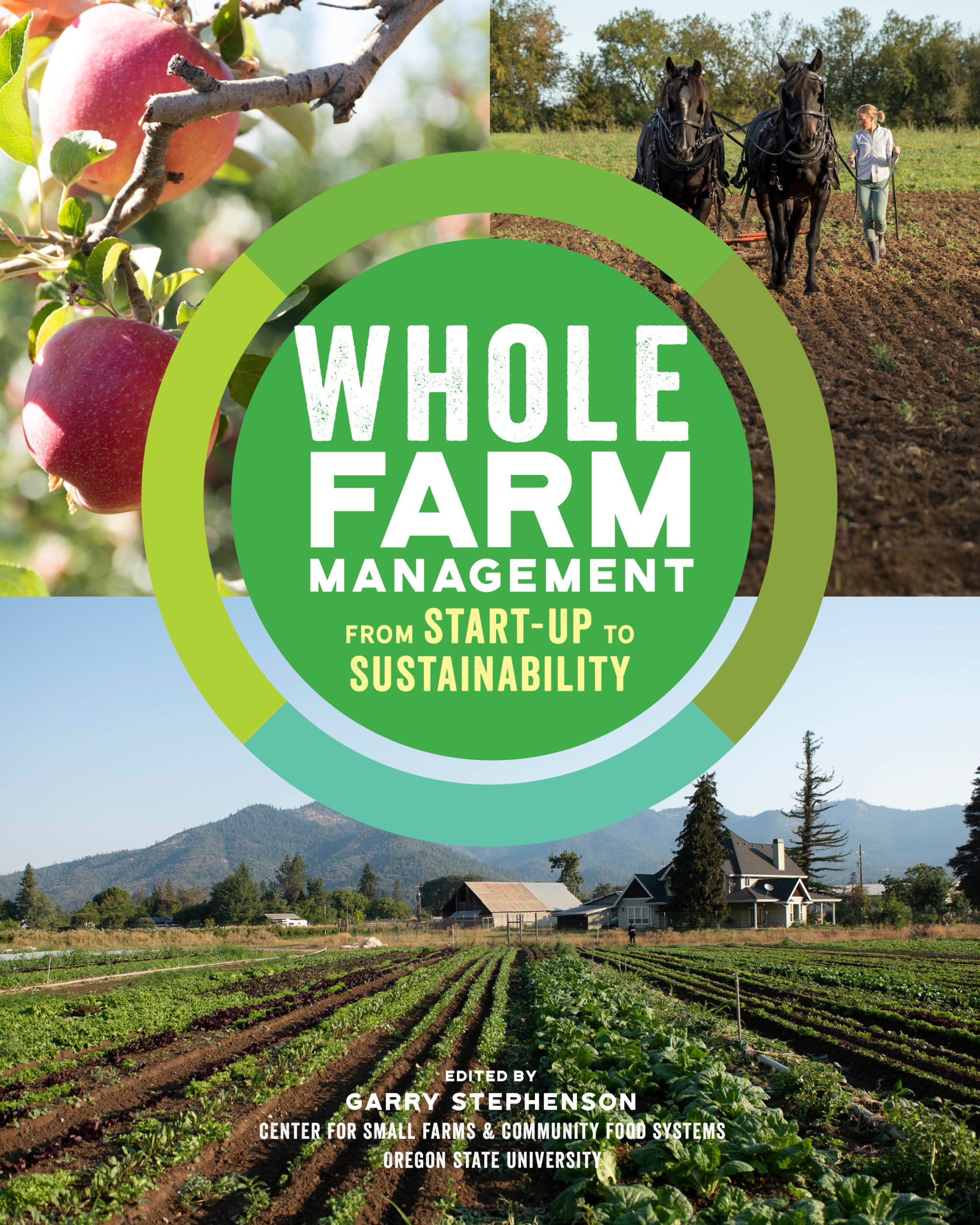Â
This is an encouraging and inspiring practical resource for beginning farmers and those growing and maintaining a farm business. It uses examples drawn from twelve farms (16 farmers). Nine of the farms are in Oregon, with one each in Missouri, Pennsylvania, and Virginia. As for diversity, three of the twelve farms have people farming while black, one has an Asian-American family, and there is a range of family relationships, including single farmers. What this book is not: how to grow lettuce, how to practice rotational grazing, how to slaughter chickens, how to prune apple trees.
Whole Farm Management is based on the curriculum from the Center for Small Farms & Community Food Systems at Oregon State University. The course is available online, and focuses on small-scale organic and sustainable agriculture through the Extension Service Small Farms Program. Royalties from book sales will support OSU beginning farmer education.
“Operating a farm business requires managing dreams, crops, people, markets, money and reality.†Whole Farm Management blends advice and inspiration from experienced farmers with guidance from ag educators. Recognizing the Manage/Learn/Succeed cycle, one of the farmers advises “You can’t know it all at once. Growing is where it starts. You have to know you can grow something before you can figure out how to sell it. But once you grow it, you have to figure out how to market. And once you’ve sold a few things, then you’re in a position to ask: can I afford to keep doing this?â€
The first one to three years of farming are about proving we can grow and sell. The next couple of years are more deliberate, less frantic. The next few years focus on how to make money. After that the question becomes “We can. Should we?†In terms of using the book, if you are in the first few years of farming, you know you can’t learn everything at once. You grab onto the bits of information you know you need. You skip over the things you don’t see an immediate need for. Learning is endless. How do you define success? Success can include the elements of social, operational, lifestyle and financial well-being.
The book follows the logical progression of training used in the OSU Growing Farms program and we can all benefit from following their well-traveled ten-year path. One or two individual farms are introduced in each chapter to illustrate particular points or aspects and the photos draw us in. There are six sections, each opening with a list of what you’ll be able to do after reading that chapter:
- Dream It – Strategic Planning. (Values, vision, mission; assessing your resources and needs; creating a foundation that matches your plan with your resources.)
- Do It – Farm Infrastructure, Labor and Energy. (How to put your resources – equipment, infrastructure, people, processes – to work.)
- Sell It – Markets and Marketing. (Developing a marketing strategy in line with your farm values, vision, mission before deciding what you will grow or raise.)
- Manage It – Business Management for the Farm. (Learning to be successful.)
- Grow It – Managing the Whole Farm Ecosystem. (Understanding the big picture and the basic principles and practices of sustainable agriculture.)
- Keep It – Entrepreneurship, Family Business Dynamics, and Managing Risk. (Planning for the long haul.)
These chapters are followed by appendices with 23 worksheets (also available online from Storey Publishers) and resources.
The arrangement of the book facilitates the learning style/stages the editor recognizes as the real way people learn. This is a book to browse initially, reading the farm profiles to get inspiration, and then return to more methodically learn specific information and skills, using the text and the worksheets. Thus fortified, you’ll be ready to assess what you need to focus on learning next. By clarifying priorities and direction, this approach helps avoid panic and the feeling of being over-whelmed.
In chapter 2 six of the farmers share their experiences about essential equipment and infrastructure, to help new farmers make a shopping list. Here is information about different systems of irrigation (although biased towards methods for Western soils). In Oregon, you can’t farm without Water Rights.
For Easterners, it can be hard to understand, as can using glacier water, snow melt or getting only 9†of rain a year. I got lost on the explanation of water drawdown and pressure head requirements. A case of skimming or skipping what you don’t need to know!
In the chapter on Markets and Marketing, six of the farms discuss aspects such as envisioning the market that will meet your needs, overcoming challenges, keeping your focus on values and goals, listening to customers, adapting a CSA model, and evolving marketing strategies over time. This chapter also looks at agritourism, u-pick, farm stands, wholesale and retail markets, and pricing.
Business Management will be vital, sooner or later in your journey. It is a process of continuous learning, continuous improvement. Here is a four-part cycle of planning and setting financial goals; implementing your plan; keeping records; assessing and analyzing your season, then round to more planning. If you want to earn your living from farming, here’s the help you might need. Consider expenses as well as sales, understand depreciation, calculate your profit (your earnings). Remember to include your management overhead time, such as making a new To Do List. Find out if it’s a better use of your time to make hay or buy it. Plan your cash flow month-by-month over the whole year, to make sure there are no avoidable dips into the red. Learn various ways farmers manage cash flow and get loans when needed. Here’s help choosing an accounting system and a record-keeping method. Here are explanations of all the accounting terms that might have left you with a sinking feeling. As Melanie Kuegler of Blue Fox farm says in closing the chapter, “So our highest value is making sure that we’re all taken care of while producing good product for people.â€
Chapter 5 on Managing the Whole Farm Ecosystem starts by reviewing the key elements needed to create a successful farm business. This chapter helps you see the whole woodland, not just the trees. Here we look at planning, and contrast that with intervention (what you do when the plan doesn’t work out). For example, in sustainable pest control, the planning might include ways to create healthy crops/livestock to resist pests; making it difficult for pests to settle in and reproduce; boosting populations of beneficial organisms. Intervention includes what you do when pest problems happen. The best interventions include adjusting your plans for the future to avoid that problem. This chapter includes cycles of energy flow, nitrogen, carbon, water, all to help us come up with strong integrated production strategies. Reading the accounts of how various farmers dealt with problems and adjusted their plan contains food for thought for all of us.
The last chapter is guidance on keeping the farm over the long haul. Risk Management is exactly as it sounds. In farming there is always risk. There are so many variables, and some of them we don’t control. We seek the serenity to accept the things we cannot change, courage to change the things we can, and the wisdom to know the difference, as Reinhold Niebuhr’s Serenity prayer puts it. Also the skill to mitigate the impact of things we cannot control but may be able to change a bit. This chapter helps us understand business opportunities, legal requirements and options, and the challenges and rewards of farming. It helps us identify steps to address risk. Several business structures are compared, along with possible interpersonal dynamics. Planning for the long term future includes handing on the farm to the next farmers, whether those are family members or not. Licenses and certifications need to be attended to, and the farmers in this book explain how they tackle those regulations and use them to distinguish the quality of their business and farm products.
The text ends with a short section of challenges and advice from seven of the farms. Staying sane by separating farm work life from non-work life; avoiding burnout by having enough workers that no-one over-does it; taking a day off each week; giving some attention to the health of the farmers as well as the soil, crops and livestock; being really clear about why you are choosing this life; accepting results that are good enough rather than being a perfectionist; distinguishing your farm by doing something superb and/or unusual; paying attention, studying and reading, talking with more experienced farmers; enjoying the sense of satisfaction and pride.
Whole Farm Management is a valuable book to make farming sustainable for the farmers, who can then provide good food for people, and contribute to a better world.








